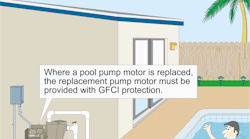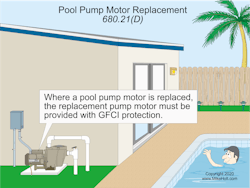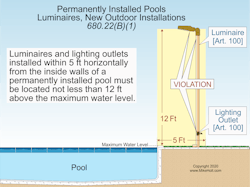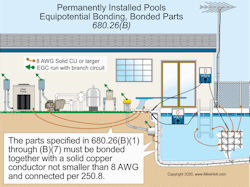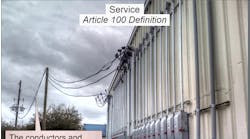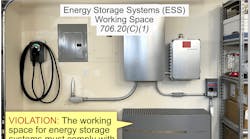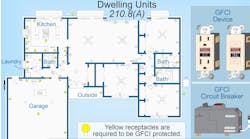Courtesy of www.MikeHolt.com. Based on the 2020 NEC.
The requirements in Art. 680 apply to the installation of electrical wiring and equipment for swimming pools, spas, hot tubs, fountains, hydromassage bathtubs, and electrically powered pool lifts.
Article 680 is divided into eight parts. Each of the last seven is dedicated to a different application. For example, Part II covers permanently installed swimming pools and Part VII covers hydromassage bathtubs.
Equipment bonding and grounding
Electrical equipment must be bonded per Part V of Art. 250 and connected to the equipment grounding conductor (EGC) per Parts VI and VII of Art. 250 [Sec. 680.6].
Terminals used for bonding and equipment grounding must be identified as suitable for use in wet and corrosive environments [Sec. 680.7]. Field-installed terminals in damp, wet, and corrosive environments must be copper, copper alloy, or stainless steel and be listed for direct burial use.
Overhead conductor clearance
Overhead conductors must meet the clearance from the maximum water level requirements contained in Table 680.9(A) [Sec. 680.9].
Permanently installed pools, spas, hot tubs, fountains, diving structures, observation stands, towers, or platforms cannot be placed within the clearances contained in Table 680.9(A).
Swimming and wading pools, diving structures, observation stands, towers, or platforms must not be installed where the maximum water level of the pool(s) and the top of the diving structures, observation stands, towers, or platforms will be less than 10 ft below communications, radio, and television coaxial cables.
Underground wiring
Underground wiring within 5 ft horizontally from the inside wall of the pool must be one of the wiring methods enumerated in Sec. 680.11(A)(1) through (7), such as intermediate metal conduit (IMC), and the minimum depths in Sec. 300.5 apply [Sec. 680.11(C)].
Equipment rooms and pits
Rooms or pits for the equipment for permanently installed pools, storable pools, spas, hot tubs, or fountain equipment must have drainage that prevents water accumulation during normal operation or filter maintenance [Sec. 680.12]. Equipment must be suitable for the corrosive environment per Sec. 300.6.
Maintenance disconnecting means
A maintenance disconnect is required for pools, storable pools, spas, hot tubs, or fountain equipment other than lighting [Sec. 680.13]. The disconnect must be readily accessible, within sight, and at least 5 ft from the pools, storable pools, spas, hot tubs, or fountain equipment unless separated from the open water by a permanently installed barrier. This horizontal distance is measured from the water’s edge along the shortest path required to reach the disconnect.
Everything we cover after this point pertains to permanently installed pools (Part II).
Motors
The wiring to a pool-associated motor must comply with Sec. 680.21(A)(1) unless modified by (A)(2) or (A)(3). For example, branch-circuit wiring methods for pool-associated motors in corrosive locations must be rigid metal conduit (RMC), IMC, rigid polyvinyl chloride conduit (PVC), reinforced thermosetting resin conduit (RTRC) [Sec. 680.14], or Type MC cable listed for the location.
Also:
Exception: Listed low-voltage motors not requiring grounding, with ratings not exceeding the low-voltage contact limit supplied by transformers or power supplies that comply with Sec. 680.23(A)(2), may be installed without GFCI protection.
Receptacles
These must comply with Sec. 680.22(A)(1) through (6). For example:
- At least one 15A or 20A, 125V receptacle must be installed on a general-purpose branch circuit.
- Receptacles for permanently installed pool motors, or other loads directly related to the circulation system, must be at least 6 ft from the inside walls of the pool and have GFCI protection [Sec. 680.22(A)(2)].
- Receptacles for loads not directly related to the circulation system must be at least 6 ft from the inside walls of a permanently installed pool [Sec. 680.22(A)(3)].
- A pool equipment room must contain at least one GFCI-protected 15A or 20A, 125V receptacle. Receptacles within the pool equipment room must be GFCI protected. [Sec. 680.22(A)(5)].
Luminaires, lighting outlets, and ceiling-suspended fans
These must comply with Sec. 680.22(B)(1) through (8). For example:
Luminaires and lighting outlets installed within 5 ft horizontally from the inside walls of a permanently installed pool must be at least 12 ft above the maximum water level [Sec. 680.22(B)(1)], as shown in Fig. 2.- Existing lighting outlets within 5 ft horizontally from the inside walls of a permanently installed pool must be at least 5 ft above the surface of the maximum water level, rigidly attached to the existing structure, and GFCI protected [Sec. 680.22(B)(3)].
- When determining the dimensions for luminaires, the distance to be measured is the shortest path an imaginary cord connected to the luminaire will follow without piercing a floor, wall, ceiling, doorway with a hinged or sliding door, window opening, or other effective permanent barriers [Sec. 680.22(B)(8)].
Underwater pool luminaires
These must comply with Sec. 680.23(A) through (F). For example:
- Transformers and power supplies for underwater pool luminaires must be listed, labeled, and identified for swimming pool use [Sec. 680.23(A)(2)].
- Underwater wall-mounted luminaires must be installed so the top of the luminaire lens is at least 18 in. below the normal water level [Sec. 680.23(A)(5)].
- A nonmetallic raceway run to the forming shell of a wet-niche luminaire must contain an 8 AWG insulated (solid or stranded) copper conductor that terminates to the forming shell [Sec. 680.23(B)(2)(b)].
- The location of the forming shell and length of flexible cord for wet-niche pool luminaires must allow personnel to place the luminaire on the deck or other dry location for maintenance [Sec. 680.23(B)(6)].
Equipotential bonding
The pool parts listed in Sec. 680.26(B)(1) through (B)(7) must be bonded together with a solid insulated or bare copper conductor not smaller than 8 AWG using a listed pressure connector, terminal bar, or other listed means per Sec. 250.8(A), as shown in Fig. 3.
These pool parts are:
- Conductive pool shells
- Perimeter surfaces
- Metallic components
- Underwater lighting
- Metal fittings
- Electrical equipment
- Fixed metal parts
Pool shells need not be constructed with unencapsulated structural reinforcing steel to be considered conductive. Cast-in-place concrete, pneumatically applied or sprayed concrete, and concrete block with painted or plastered coatings are considered conductive materials due to water permeability and porosity. Vinyl liners and fiberglass composite shells are considered non-conductive materials.
The bonding requirements for some of these, such as perimeter surfaces, are highly detailed. The gist of the detailed requirements is that you create a bonding path of sufficient size and reliability to ensure there’s no difference in potential between conductive parts. For example, consider these details for perimeter surfaces (these are new with the 2020 revision):
(1) The copper ring is constructed of 8 AWG bare solid copper or larger.
(2) The copper ring conductor follows the contour of the perimeter surface.
(3) Only listed splicing devices or exothermic welding are used.
(4) The copper ring conductor is placed between 18 in. and 24 in. from the inside walls of the pool.
(5) The copper ring conductor is secured within or under the perimeter surface 4 in. to 6 in. below the subgrade.
Where a double-insulated water pump motor is installed, provide a solid 8 AWG copper conductor of sufficient length to make a bonding connection to a replacement motor from the swimming pool equipotential bonding means to an accessible point in the vicinity of the pool pump motor [680.26(B)(6)(a)].
Where there is no connection between the swimming pool equipotential bonding means and the equipment grounding system for the premises, connect this bonding conductor to the EGC of the motor circuit.
Fixed metal parts such as metal-sheathed cables and raceways, metal piping, metal awnings, metal fences, and metal door and window frames located within 5 ft horizontally [Sec. 680.26(B)(7), Exception No. 2] and 12 ft vertically [Sec. 680.26(B)(7), Exception No. 3] from the inside wall of the pool, must be connected to the swimming pool equipotential bonding means [Sec. 680.26(B)(7)].
But you don’t have to bond parts that are separated from the pool by a permanent barrier that prevents contact by a person or those that are separated by a distance greater than 5 ft horizontally from the inside walls of the pool.
Safely installing permanent pools
While most of the requirements for permanently installed pools focus on keeping electricity separated from water and people, many of the requirements address eliminating differences of potential (voltage) between metallic objects. This is done by bonding all metal parts in the vicinity of a swimming pool. This is where errors often occur, but you can catch those errors by visually tracing out the bonding path and drawing it on paper as you go.
These materials are provided to us by Mike Holt Enterprises in Leesburg, Fla. To view Code training materials offered by this company, visit www.mikeholt.com/code.
